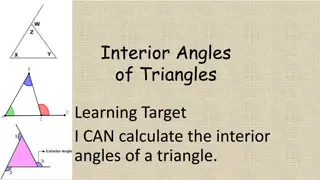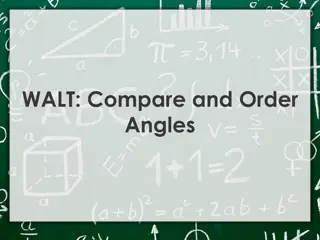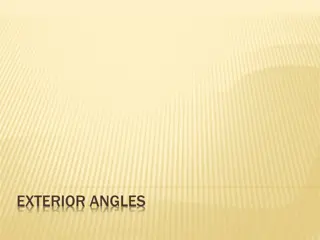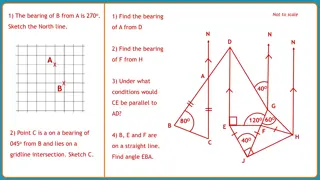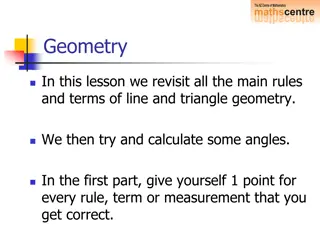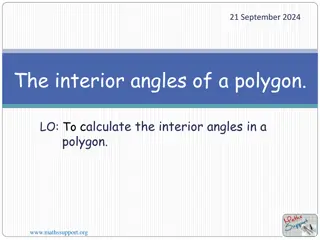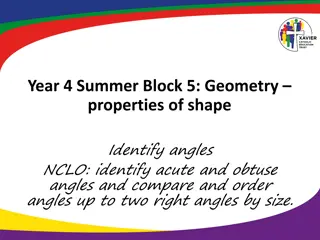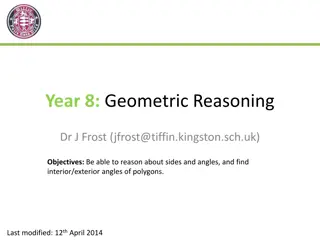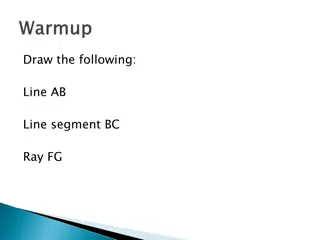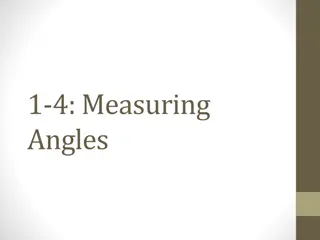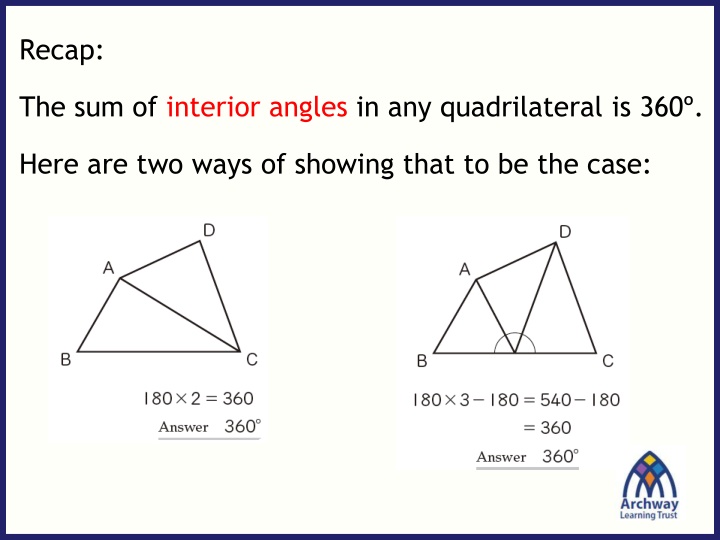
Discovering the Interior Angle Sum of Polygons
Uncover the secret behind the sum of interior angles in polygons through methods like triangle splitting. Explore how the sum always equals 360 degrees, apply this knowledge to find specific angles, and learn different ways to approach polygons of various sides.
Download Presentation

Please find below an Image/Link to download the presentation.
The content on the website is provided AS IS for your information and personal use only. It may not be sold, licensed, or shared on other websites without obtaining consent from the author. If you encounter any issues during the download, it is possible that the publisher has removed the file from their server.
You are allowed to download the files provided on this website for personal or commercial use, subject to the condition that they are used lawfully. All files are the property of their respective owners.
The content on the website is provided AS IS for your information and personal use only. It may not be sold, licensed, or shared on other websites without obtaining consent from the author.
E N D
Presentation Transcript
Recap: The sum of interior angles in any quadrilateral is 360 . Here are two ways of showing that to be the case:
On your whiteboards, complete the explanation for the first method below: First, split quadrilateral ABCD into two triangles with diagonal AC. Since the sum of the three angles of a triangle is 180
Now look at the second method and complete the sentence on your whiteboards. First, split quadrilateral ABCD into three triangles with lines joining A and D to the midpoint of BC. Since there are three triangles, multiply 180 by three. 180 must then be subtracted from the total because
Here is a third way of finding the sum of interior angles in a quadrilateral. Complete the working out on your whiteboards.
Summary. The sum of interior angles of a quadrilateral can be found by splitting the shape into triangles. The angle sum of a quadrilateral is always 360
Use the fact that the angle sum of a quadrilateral is 360 to find the angles A, B and C
Find the angle sum of a pentagon and hexagon by splitting into triangles (or triangles and quadrilaterals). Find at least two ways of splitting each shape.
Fill in the table below by splitting each of the shapes into triangles using this method: Number of Sides Name of Shape Minimum Number of triangles 1 2 3 4 5 6 Interior Angle Sum 180 360 540 720 900 1080 Triangle 3 4 5 6 7 8 Quadrilateral Pentagon Hexagon Heptagon Octagon
Use the results in your table to find the interior angle sum of a dodecagon (12-sided shape). Number of Sides Name of Shape Minimum Number of triangles 1 2 3 4 5 6 Interior Angle Sum 180 360 540 720 900 1080 Triangle 3 4 5 6 7 8 Quadrilateral Pentagon Hexagon Heptagon Octagon
Use the results in your table to find the interior angle sum of an icosagon (20-sided shape). Number of Sides Name of Shape Minimum Number of triangles 1 2 3 4 5 6 Interior Angle Sum 180 360 540 720 900 1080 Triangle 3 4 5 6 7 8 Quadrilateral Pentagon Hexagon Heptagon Octagon
Use the results in your table to find the interior angle sum of an n-agon (n-sided shape). Number of Sides Name of Shape Minimum Number of triangles 1 2 3 4 5 6 Interior Angle Sum 180 360 540 720 900 1080 Triangle 3 4 5 6 7 8 Quadrilateral Pentagon Hexagon Heptagon Octagon
Sum of interior angles n-sided polygon = 180(? 2) Use this formula to find the sum of interior angles of a 14 sided shape Interior angle sum = 180(n - 2) Interior angle sum = 180(14 - 2) Interior angle sum = 180(12) Interior angle sum = 2160
Using what we have learnt today, how could you find the size of one of the interior angles in: A regular pentagon A regular hexagon A regular octagon If the shape is regular then all of the sides are the same size and all of the angles are the same size How does this help?
Using what we have learnt today, how could you find the size of one of the interior angles in: A regular pentagon A regular hexagon A regular octagon If we know the interior angle sum, and the number of equal angles then we can simply divide the sum by the number of angles
Using what we have learnt today, how could you find the size of one of the interior angles in: A regular pentagon A regular hexagon A regular octagon 540 5 = 108 720 6 = 120 900 8 = 112.5
The diagram shows a regular pentagon and a regular decagon. Annabel is trying to find the size of angle x. x Do you agree with her solution?


